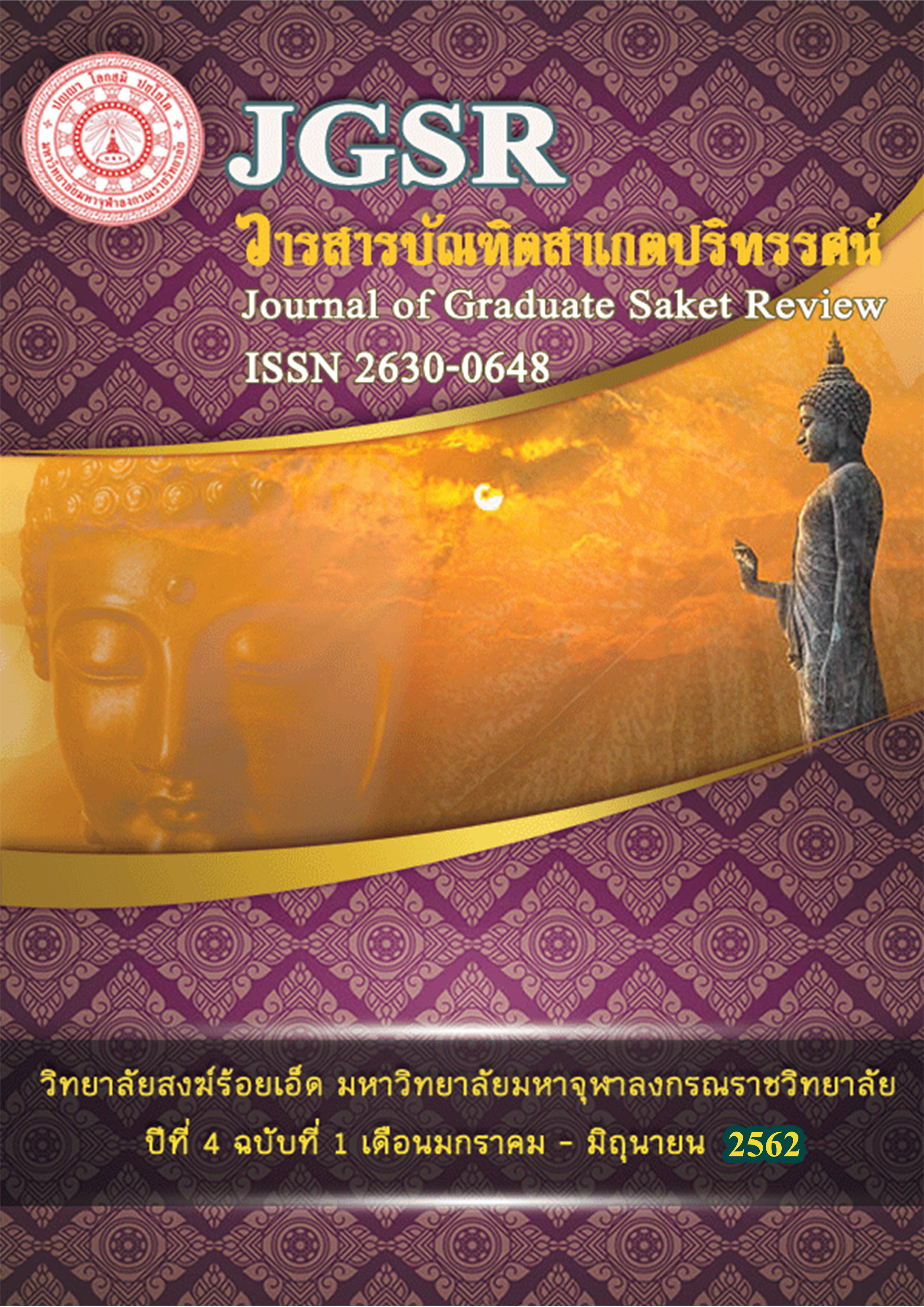The Role of Buddhism on the Online Social Networking “Facebook”
Main Article Content
Abstract
This research article is of 3 objectives namely: 1) to study the role of Buddhism in Thai society on Facebook ; 2) to demonstrate the role of Buddhism in Thai society on Facebook ; 3) To analyze the role Buddhism in Thai society on Facebook.
From the study, it is found that the Online Social Networking i.e. Facebook, reflects the religious phenomena in all 7 dimensions namely:- (1) Practical and Meditation dimensions, (2) Dhamma and Doctrinal dimensions, (3) Narrative and Mythic dimensions, (4) Religious Experiential dimensions, (5) Moral dimensions, (6) Social and Institutional dimensions, (7) Material and Artistic dimensions. To speak more precisely, All of 7 dimensions are found on the 4 chosen profiles, viz. (1) “PhraPaisalVisalo” which is of individual and public profiles of PhraPaisālVisālo, (2) “พระมหาวุฒิชัยวชิรเมธี” and “ว.วชิรเมธี (W. Vajiramedhi)” which are the public profiles of PhramahāWutthichaiVajiramedhī, (3) “หอจดหมายเหตุพุทธทาสอินทปัญโญ : BuddhadasaIndapañño Archives” which is the public profile of BuddhadāsaIndapañño Archives, (4) “เสถียรธรรมสถานSathiraDhammasathan” which is the public profile of SathiraDhammasathān. While “Tilopa House”, the public profile of Tilopa House by VichakPanich, is the only one profile that Narrative and Mythic dimensions are not found.
Moreover, the role of Buddhism that are presented in the 7 dimensions of religion that reflect the representation of Buddhism in Thai society on Facebook in 5 kinds of meaning namely: (1) Worldly Buddhism, (2) Pluralistic Buddhism, (3) Value of nature-recognized Buddhism, (4) Lay-person Buddhism and (5) “Stream-counter” Buddhism. This representation is constructed by globalization and the rapid growth of new media i.e. Facebook. These conditions force Buddhism to change its “place” significantly in the present day.
Article Details
เนื้อหาและข้อมูลในบทความที่ลงตีพิมพ์ในวารสารบัณฑิตสาเกตปริทรรศน์ ถือเป็นข้อคิดเห็นและความรับผิดชอบของผู้เขียนบทความโดยตรงซึ่งกองบรรณาธิการวารสาร ไม่จำเป็นต้องเห็นด้วย หรือร่วมรับผิดชอบใด ๆบทความ ข้อมูล เนื้อหา รูปภาพ ฯลฯ ที่ได้รับการตีพิมพ์ในวารสารบัณฑิตสาเกตปริทรรศน์ ถือเป็นลิขสิทธิ์ของวารสารบัณฑิตสาเกตปริทรรศน์ หากบุคคลหรือหน่วยงานใดต้องการนำทั้งหมดหรือส่วนหนึ่งส่วนใดไปเผยแพร่ต่อหรือเพื่อกระทำการใด ๆ จะต้องได้รับอนุญาตเป็นลายลักอักษรจากวารสารบัณฑิตสาเกตปริทรรศน์ ก่อนเท่านั้น
References
กาญจนา แก้วเทพ. (2539). สื่อส่องวัฒนธรรม. กรุงเทพมหานคร :อมรินทร์.
กาญจนา แก้วเทพและสมสุข หินวิมาน. (2551). สายธารแห่งนักคิดทฤษฎีเศรษฐศาสตร์การเมืองกับสื่อสารศึกษา. กรุงเทพมหานคร
: ภาพพิมพ์.
ไชยรัตน์ เจริญสินโอฬาร. (2545). ขบวนการเคลื่อนไหวทางสังคมรูปแบบใหม่. พิมพ์ครั้งที่ 2. กรุงเทพมหานคร: วิภาษา.
ไชยรัตน์ เจริญสินโอฬาร. (2545). สัญวิทยา โครงสร้างนิยม หลังโครงสร้างนิยมกับการศึกษารัฐศาสตร์. กรุงเทพมหานคร : วิภาษา.
ประทุมพร วัชรเสถียร. (2548). โลกร่วมสมัย: ตอบคำถามของคนรุ่นใหม่. กรุงเทพมหานคร: ปาเจรา.
พระธรรมปิฎก (ป.อ.ปยุตฺโต). (2543). ความสำคัญของพระพุทธศาสนาในฐานะศาสนาประจำชาติ. พิมพ์ครั้งที่ 10. กรุงเทพมหานคร
: สหธรรมิก.
ราชบัณฑิตยสถาน. (2549). พจนานุกรมศัพท์สังคมวิทยาอังกฤษ – ไทย. พิมพ์ครั้งที่ 3. กรุงเทพมหานคร: ราชบัณฑิตยสถาน.
โรล็องด์ บาร์ตส์. (2551). มายาคติ. แปลโดย วรรณพิมล อังคศิริสรรพ. พิมพ์ครั้งที่ 3. กรุงเทพมหานคร : คบไฟ.
วิทยากร เชียงกูล. (2547). อธิบายศัพท์ใหม่เพื่อเข้าใจโลกยุคใหม่. พิมพ์ครั้งที่ 2. กรุงเทพมหานคร : สายธาร.
สุริชัย หวันแก้ว. (2546). กระบวนการกลายเป็นคนชายขอบ Marginalization. กรุงเทพมหานคร: คณะกรรมการสภาวิจัยแห่งชาติ
สาขาสังคมวิทยา สำนักงานคณะกรรมการวิจัยแห่งชาติ.
อานันท์ กาญจนพันธุ์. (2545). เส้นผมบังภูเขา: ความคิดสามัญเชิงวิพากษ์. กรุงเทพมหานคร: เคล็ดไทย.
เอก ตั้งทรัพย์วัฒนา. (2548). โลกาภิวัตน์ บรรษัทข้ามชาติ. กรุงเทพมหานคร : สำนักพิมพ์แห่งจุฬาลงกรณ์มหาวิทยาลัย.
Appadurai, Arjun. (1996). Modernity at Large : Cultural Dimension of Globalization. Minneapolis: University of
Minnesota Press.
Beck, Ulrich. (1992). Risk Society: Towards a New Modernity. London: Sage.
Rosenau, James N. (1997). Along the Domestic-Foreign Frontier: Exploring Governance in a Turbulent World.
Cambridge: Cambridge University Press.
Urry John. (2003). Global Complexity. Cambridge: Polity.


